Cooking rice can be a convenient and efficient way to prepare a delicious and healthy meal. However, one common issue that many rice cooker users face is their rice cooker bubbling over and causing a mess. If you’ve been wondering “why does my rice cooker bubble over?” don’t worry, we’ve got you covered.
In this article, we’ll explore the reasons behind your rice cooker bubbling over and provide practical tips to prevent it from happening. From the incorrect rice-to-water ratio to cooking rice at high temperatures, we’ll cover all the potential factors contributing to the issue.
Key Takeaways:
- Understanding the causes of rice cooker bubbling can help prevent messes and maintain your rice cooker.
- An incorrect rice-to-water ratio, starch buildup, cooking rice at high temperatures, and overfilled rice cookers are all common causes of bubbling.
- Maintaining and cleaning your rice cooker is essential for optimal performance.
Common Causes of Rice Cooker Bubbling
Have you ever left your rice cooker unattended only to find it overflowing with bubbles when you return? This is a common problem that many home cooks face. Here are some of the common causes of rice cooker bubbling:
| Cause | Solution |
|---|---|
| Incorrect rice-to-water ratio | Ensure that you measure the rice and water precisely and follow the recommended ratios for your rice cooker. Use measuring cups or the markings inside the rice cooker to measure the correct amounts of rice and water. |
| Starch buildup | Clean your rice cooker regularly, following the manufacturer’s instructions. Avoid using abrasive cleaning products or tools that can damage the inner surface of the rice cooker. |
| Cooking rice at high temperatures | Lower the heat on your rice cooker or cook rice for a longer period of time to avoid excessive bubbling. |
| Type of rice used | Choose the appropriate type of rice for your rice cooker and adjust the amount of water accordingly. |
| Overfilled rice cooker | Do not overfill your rice cooker with rice and water. Follow the recommended amounts according to your rice cooker’s instructions. |
| Faulty rice cooker seal | Check the seal on your rice cooker’s lid for any damage or debris. Replace the seal if necessary to ensure a tight seal and prevent excessive bubbling. |
| Cooking rice too quickly | Reduce the heat on your rice cooker or cook rice for a longer period of time to avoid excessive bubbling. |
| Excessive foaming | Add a few drops of oil to your rice cooker before cooking to reduce foaming, or rinse the rice thoroughly before cooking to remove excess starch. |
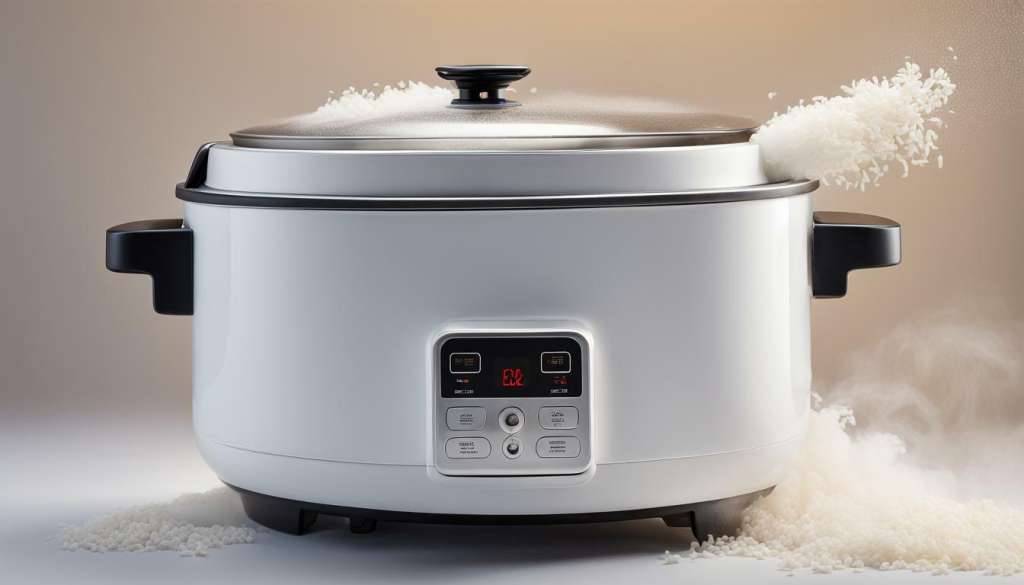
By understanding the common causes of rice cooker bubbling and following preventative measures, you can save yourself the hassle of cleaning up a messy kitchen. In the next sections, we’ll delve deeper into each of these causes and provide more detailed solutions to prevent your rice cooker from bubbling over.
Incorrect Rice-to-Water Ratio
One of the most common reasons why rice cookers bubble over is due to an incorrect rice-to-water ratio. It’s essential to measure the right proportions of rice and water to ensure that your rice cooks correctly and without making a mess.
If you’re experiencing bubbling, take a look at the instructions provided with your rice cooker and check to make sure you’re using the correct ratio for the type of rice you’re cooking. As a general rule, the ratio for most rice cookers is one cup of rice to one and a half cups of water.
If you’ve already followed the instructions correctly, the issue may lie with the rice or the cooker itself. For example, some rice varieties may require less water, while others may need more. Additionally, using too much or too little rice can result in bubbling over.
If you’ve checked your instructions and are still experiencing issues, try adjusting the ratio slightly and monitor the rice during cooking. If it continues to bubble over, you may need to troubleshoot your rice cooker further.
To prevent rice cooker bubbling over, always measure the correct ratio of rice to water, adjust if necessary, and troubleshoot any potential issues with your rice cooker.
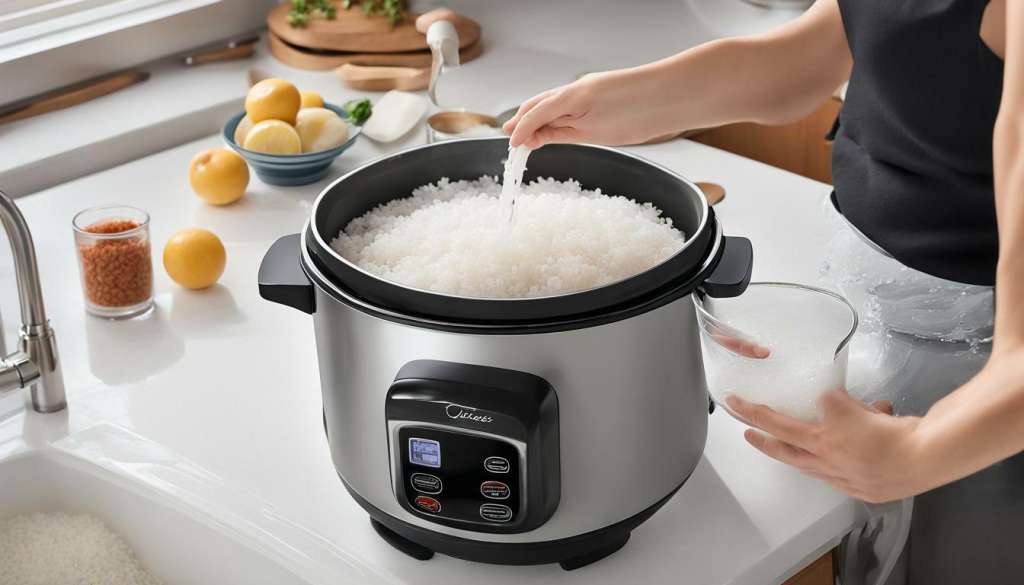
Starch Buildup
One of the most common causes of rice cooker bubbling is starch buildup on the inner surface of the cooker. Over time, starch residue can accumulate and affect the cooker’s performance. If left unattended, buildup can cause the cooker to overheat and bubble over.
To avoid starch buildup, it is essential to clean your rice cooker regularly. After each use, allow the cooker to cool down completely and then wipe the inner lid and bowl with a soft, damp cloth. Avoid using abrasive sponges or cleaning agents that could damage the non-stick coating. In addition to regular cleaning, you may want to consider deep-cleaning your rice cooker on occasion.
To deep-clean your rice cooker, mix a solution of equal parts water and vinegar, and fill the cooker to the maximum water level. Run a normal cooking cycle, and let the cooker sit for at least an hour. After an hour, discard the solution, rinse the cooker thoroughly, and dry it thoroughly. Regular cleaning and maintenance can prolong your rice cooker’s lifespan and prevent potential issues.
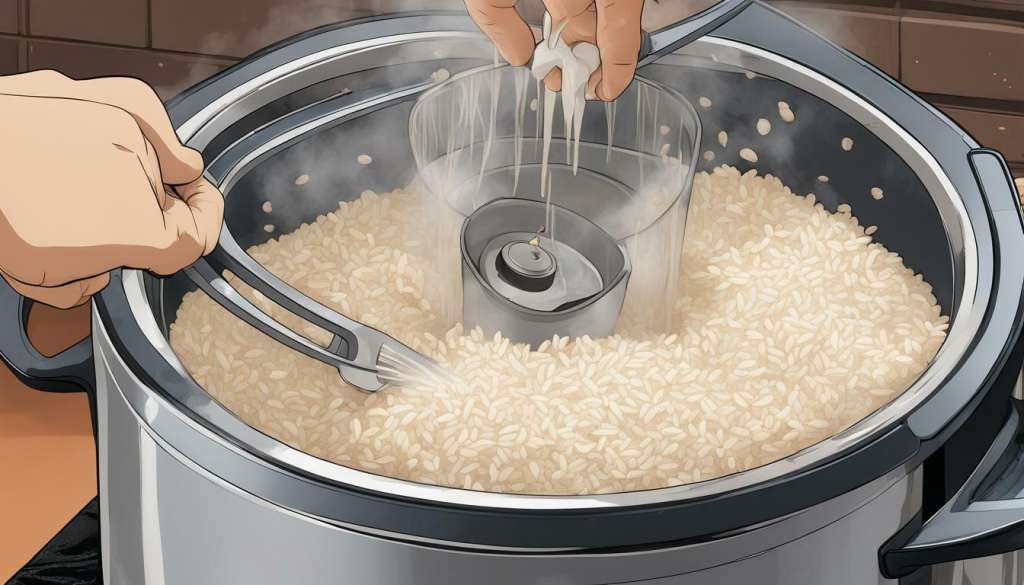
If you experience excessive bubbling despite proper maintenance, it may be time to replace your cooker’s inner pot. Over time, the non-stick coating on the pot can wear down, leading to increased starch buildup and performance issues. Check your rice cooker manufacturer’s website for replacement parts or contact their customer service for assistance.
Cooking Rice at High Temperatures
When cooking rice at high temperatures, you’re more likely to experience bubbling over in your rice cooker. This happens because the water boils too rapidly, causing excessive steam buildup and resulting in bubbles overflowing the pot. To avoid this problem, consider cooking rice at lower temperatures. This will help you slow down the boiling process and reduce the amount of steam that’s produced. Try reducing the heat setting on your rice cooker and cooking for a longer period of time to allow the rice to cook evenly without boiling over.
Another solution is to use a different cooking method altogether, such as stovetop rice cooking. This allows you to have more control over the heat settings and adjust them as needed. Plus, it requires less water, which minimizes the chance of bubbling over.
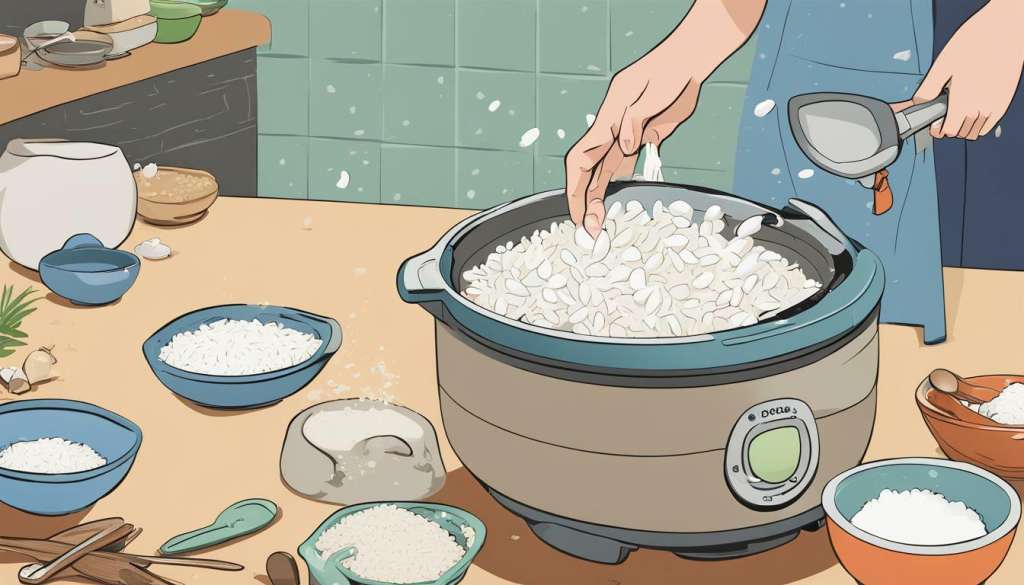
Type of Rice Used
The type of rice used in your rice cooker can also contribute to bubbling over. Different rice varieties have varying starch content, which affects the texture of the cooked rice and can cause bubbling. Short-grain rice, for instance, is stickier than long-grain rice and may require more water to cook properly. Using too much water can result in excessive bubbling. Basmati rice is another type that is known to cause bubbling over due to its high starch content.
To troubleshoot this issue, check the packaging of your rice to determine the recommended rice-to-water ratio. Adjust the water to rice ratio accordingly to prevent bubbling over. Additionally, rinsing the rice before cooking can help reduce the starch content and minimize bubbling.
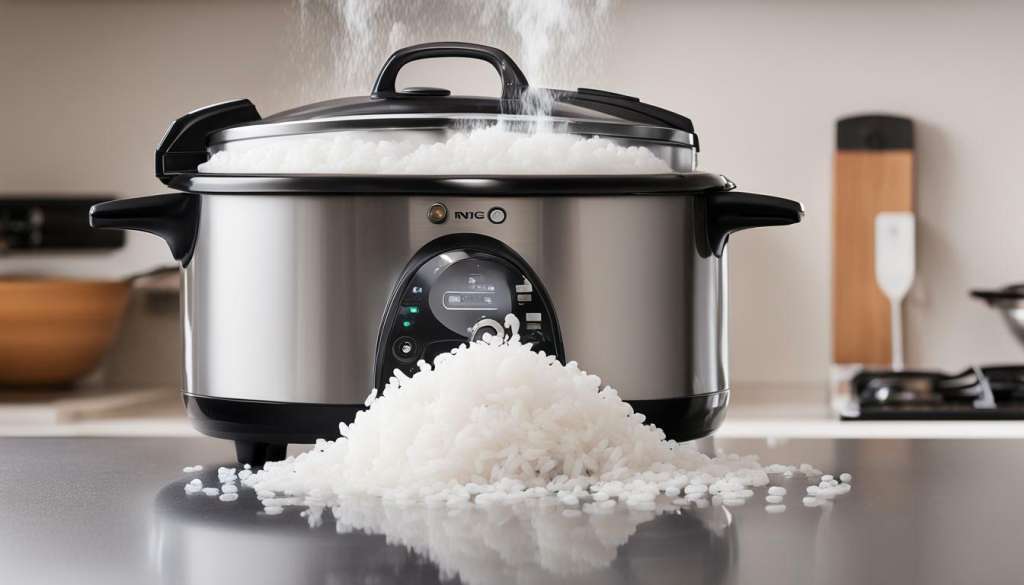
Overfilled Rice Cooker
If you’re finding your rice cooker overflowing with bubbles, it could be because you’re overfilling it. It can be tempting to add an extra scoop of rice, but doing so can cause the rice to expand and bubble over, making a mess in the process. To avoid this, never fill your rice cooker above the recommended fill line. If you’re unsure of how much rice to add, consult the rice cooker’s instructions or use measuring cups to measure the appropriate amount of rice and water.
Another important tip is to avoid opening the lid while the rice is cooking, as this can cause steam to escape and disrupt the cooking process. If you need to check on the rice, try to do so quickly and limit the amount of time the lid is open.
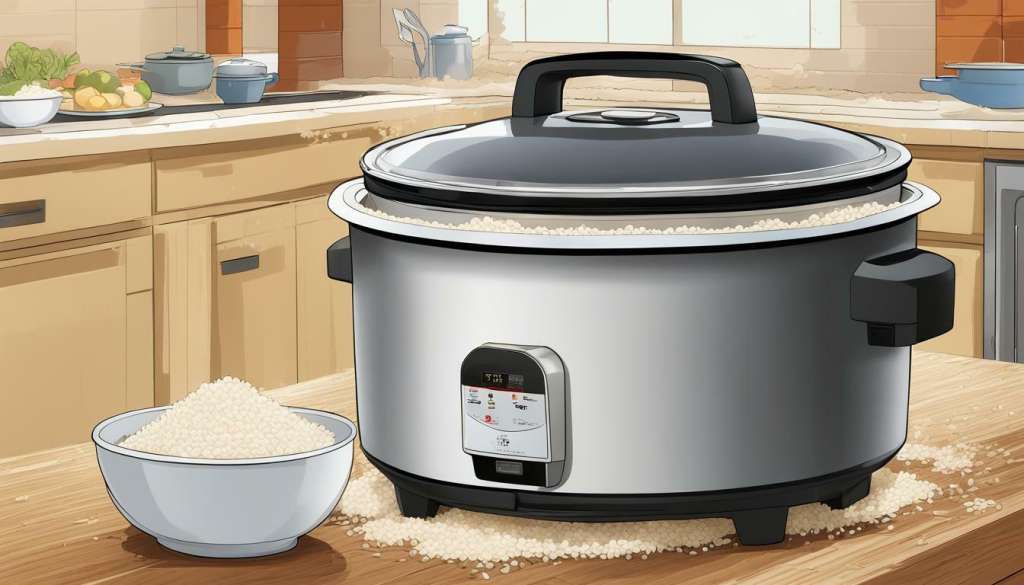
By following these simple tips, you can prevent your rice cooker from overflowing and keep your kitchen clean and tidy.
Faulty Rice Cooker Seal
Another issue that can cause excessive bubbling in your rice cooker is a faulty seal on the lid. Over time, the seal may become worn or damaged, allowing steam to escape and resulting in the buildup of pressure inside the cooker. This buildup can cause the water to boil too quickly, leading to bubbling over.
To prevent this problem, it’s essential to regularly inspect your rice cooker’s seal for any signs of wear or damage. Be sure to clean it thoroughly after each use to prevent any buildup of rice or debris that could compromise the seal. If you notice any issues with the seal, such as cracks or leaks, it’s best to replace it as soon as possible to ensure efficient and safe cooking.
Maintaining your rice cooker’s seal and addressing any issues promptly can prevent excessive bubbling and ensure that your rice is cooked perfectly every time.
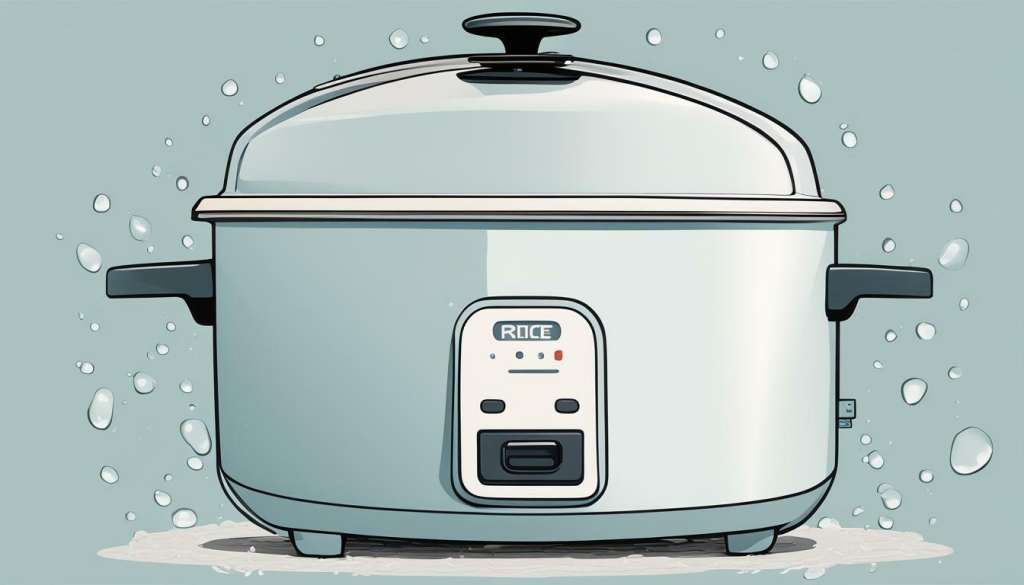
Cooking Rice Too Quickly
If you’re cooking rice at high temperatures, you’re likely to encounter bubbling. This happens because the water in the rice cooker boils too quickly, producing steam that needs to escape. When there isn’t enough room for the steam to escape, it creates bubbles and eventually leads to overflow.
An easy solution to this problem is to use the right settings on your rice cooker. Most rice cookers have a setting for cooking rice at a slower pace, which allows the water to boil at a more controlled rate. Using a lower heat setting or reducing the cooking time can also help prevent bubbling. It may take a bit longer to cook, but the end result will be worth it.
If you’re in a rush and need to cook rice quickly, try soaking it in cold water for 30 minutes before cooking. This will help the rice absorb water and cook more evenly, reducing the risk of bubbling. Additionally, rinsing your rice before cooking removes excess starch that can cause bubbles.
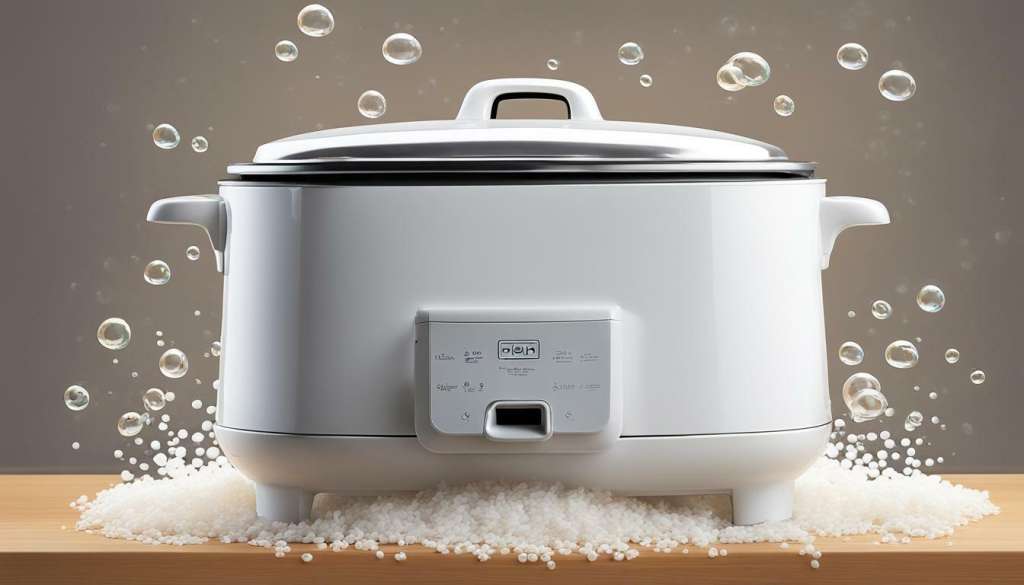
Excessive Foaming
Excessive foaming is another cause of rice cooker bubbling over. When cooking rice, starch forms a frothy layer on the surface of the water that can create excessive foaming in the cooker. This foam can clog the pressure valve and cause the pressure to build up in the cooker, leading to bubbling over.
To prevent excessive foaming in your rice cooker, try the following solutions:
- Wash the rice thoroughly before cooking to remove excess starch.
- Use a lower heat setting or reduce cooking time to slow down the boiling process and prevent foaming.
- Add a few drops of oil to the water before cooking to break up the starch and prevent it from foaming.
- Use a larger cooker than needed to allow more room for the rice to expand and reduce the chance of overflow.
By following these tips, you can prevent excessive foaming and keep your rice cooker from bubbling over.
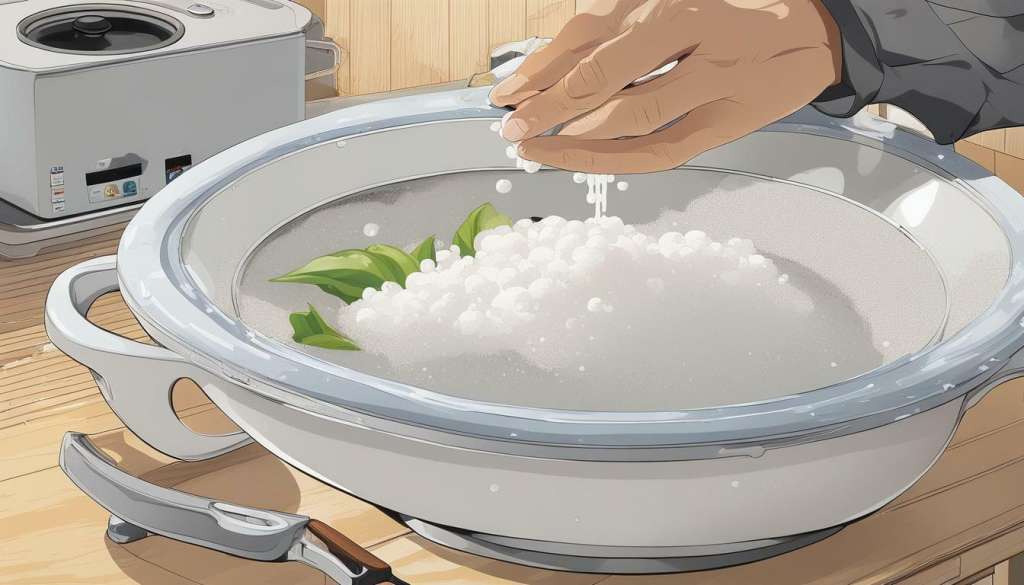
Cleaning and Maintenance Tips
Proper cleaning and maintenance are essential to ensuring your rice cooker performs at its best. Neglecting regular care can result in various problems, including bubbling over, reduced cooking performance, and even breakage.
To keep your rice cooker in good condition, follow these maintenance tips:
- Regular cleaning: After each use, make sure to empty the inner pot and clean it thoroughly with warm, soapy water. Avoid using abrasive materials that can scratch the surface. Rinse the pot and dry it thoroughly before using it again.
- Deep cleaning: If you notice any staining or buildup on the inner pot, you may need to do a deep cleaning. Mix equal parts of vinegar and water and soak the inner pot for a few hours. Rinse it with warm water and dry it thoroughly.
- Inspecting the lid seal: Over time, the seal on the rice cooker’s lid can become worn or damaged, which can cause bubbling over. Regardless of the type of rice cooker you’re using, make sure to inspect the seal regularly to ensure it’s in good condition. If you notice any wear or damage, replace the seal immediately.
- Checking the power cord: Ensure the power cord is not damaged. If it is, do not use the rice cooker and replace the cord.
- Storing the rice cooker: Store the rice cooker in a dry place and avoid stacking heavy objects on top of it. Maintain the device in a clean enclosed space with proper ventilation.
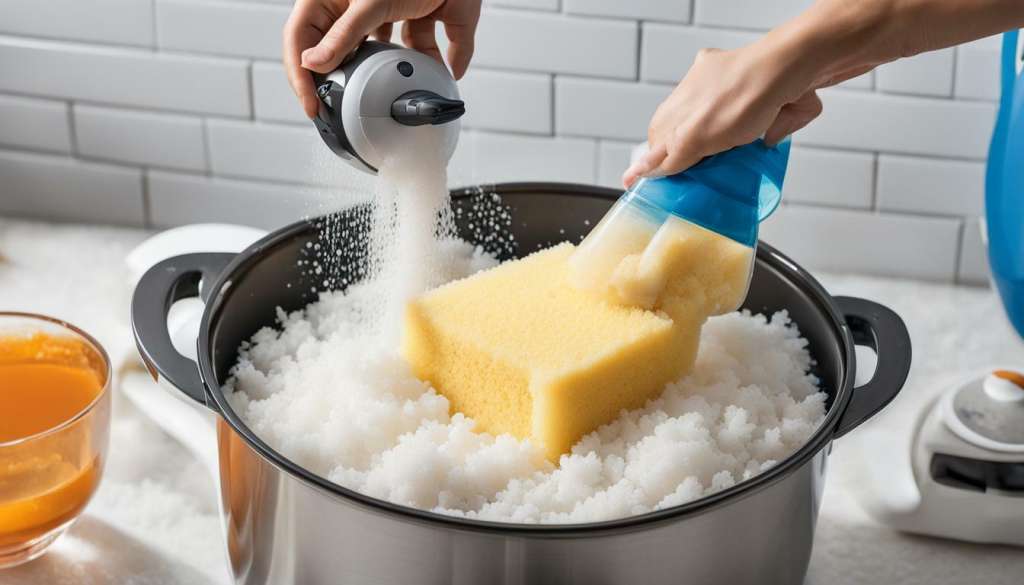
By following these simple tips, you can extend the life of your rice cooker, prevent bubbling over, and ensure the best possible cooking performance. Regular maintenance is critical to keep the appliance running at its optimal level and avoid any potential issues.
Conclusion
In conclusion, preventing bubbling in your rice cooker requires diligence and attention to detail. Maintaining the correct rice-to-water ratio, cleaning your rice cooker regularly, and selecting the appropriate cooking temperature and time all play crucial roles in preventing rice cooker bubbling. Additionally, choosing the right type of rice and avoiding overfilling the rice cooker are key factors in preventing overflow and mess. If you experience any issues with your rice cooker, such as excessive bubbling, foaming or overflowing, don’t panic! Troubleshoot the problem by following our useful tips and maintain your rice cooker regularly to get the most out of your investment. With proper care, your rice cooker will provide delicious and perfectly cooked rice for years to come.
FAQ
Q: Why does my rice cooker bubble over?
A: Rice cookers can bubble over due to various factors such as an incorrect rice-to-water ratio, starch buildup, cooking rice at high temperatures, using certain types of rice, overfilling the cooker, a faulty seal, cooking rice too quickly, or excessive foaming.
Q: What are the common causes of rice cooker bubbling?
A: The common causes of rice cooker bubbling include an incorrect rice-to-water ratio, starch buildup, cooking rice at high temperatures, using certain types of rice, overfilling the cooker, a faulty seal, cooking rice too quickly, or excessive foaming.
Q: How can I prevent rice cooker bubbling over?
A: To prevent rice cooker bubbling over, make sure to measure the rice and water in the right proportions, clean and maintain your rice cooker regularly to prevent starch buildup, avoid cooking rice at high temperatures, use rice varieties that are less likely to cause bubbling, do not overfill the cooker, check for a faulty seal and fix it if necessary, cook rice at a slower pace, and minimize foaming.
Q: How do I adjust the rice-to-water ratio to prevent bubbling over?
A: To adjust the rice-to-water ratio and prevent bubbling over, follow the recommended measurements specified in the rice cooker’s instructions. Generally, the ratio is 1:1 for white rice and 1:1.5 or 1:2 for brown rice. You can also experiment to find the ratio that works best for your desired texture.
Q: How can I maintain my rice cooker to prevent starch buildup?
A: To prevent starch buildup in your rice cooker, rinse the rice thoroughly before cooking, clean the inner surface of the cooker regularly using a non-abrasive sponge or cloth, avoid leaving cooked rice in the pot for too long, and descale the cooker occasionally using a mixture of vinegar and water.
Q: What are some alternative methods to avoid cooking rice at high temperatures?
A: To avoid cooking rice at high temperatures, you can try pre-soaking the rice for 30 minutes before cooking, using the low or medium heat setting on your rice cooker, or using a lower wattage rice cooker that cooks at a gentler heat.
Q: Which types of rice are more likely to cause bubbling in a rice cooker?
A: Sticky or glutinous rice varieties are more likely to cause bubbling in a rice cooker due to their higher starch content. To prevent bubbling, reduce the amount of water used when cooking these types of rice or adjust the cooking time.
Q: How much rice should I put in my rice cooker to avoid overflowing with bubbles?
A: To avoid overflowing with bubbles, it’s important not to overfill your rice cooker. Follow the recommended maximum fill line indicated in your rice cooker’s instructions to ensure there is enough space for the rice to expand during cooking.
Q: How can I fix a faulty seal on my rice cooker’s lid?
A: If you suspect a faulty seal on your rice cooker’s lid, inspect it for any cracks or damage. If necessary, replace the seal with a new one following the manufacturer’s instructions. Properly sealing the lid will help prevent excessive bubbling.
Q: Why should I cook rice at a slower pace to avoid bubbling over?
A: Cooking rice at a slower pace allows for more even heat distribution, reducing the likelihood of bubbling over. Using a lower heat setting on your rice cooker or extending the cooking time slightly can help achieve better results.
Q: How can I minimize excessive foaming in my rice cooker?
A: To minimize excessive foaming, rinse the rice thoroughly before cooking, avoid using too much water, use a larger capacity rice cooker to allow more space for the rice to expand, and add a small amount of oil or butter to the rice before cooking.
Q: What are some essential cleaning and maintenance tips for my rice cooker?
A: To keep your rice cooker in top shape, regularly clean the inner pot, lid, and accessories using warm soapy water, avoid using abrasive cleaners or utensils that can scratch the non-stick surface, remove any residual rice or food particles after each use, and descale the cooker periodically using a vinegar and water solution.
Q: How important is it to follow preventative measures to avoid rice cooker bubbling over?
A: Following preventative measures is crucial to avoid rice cooker bubbling over and ensure efficient cooking. By maintaining the correct rice-to-water ratio, cleaning and maintaining your rice cooker, using appropriate rice varieties, and avoiding common mistakes, you can enjoy perfectly cooked rice without the hassle of bubbling over.


